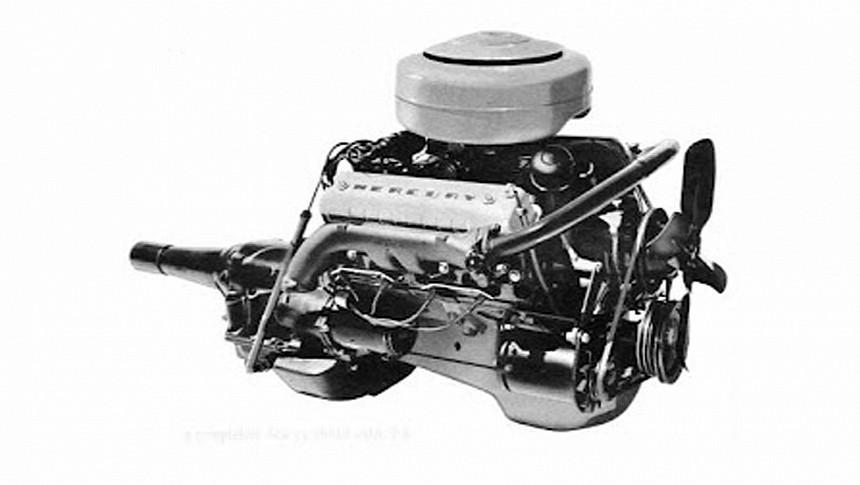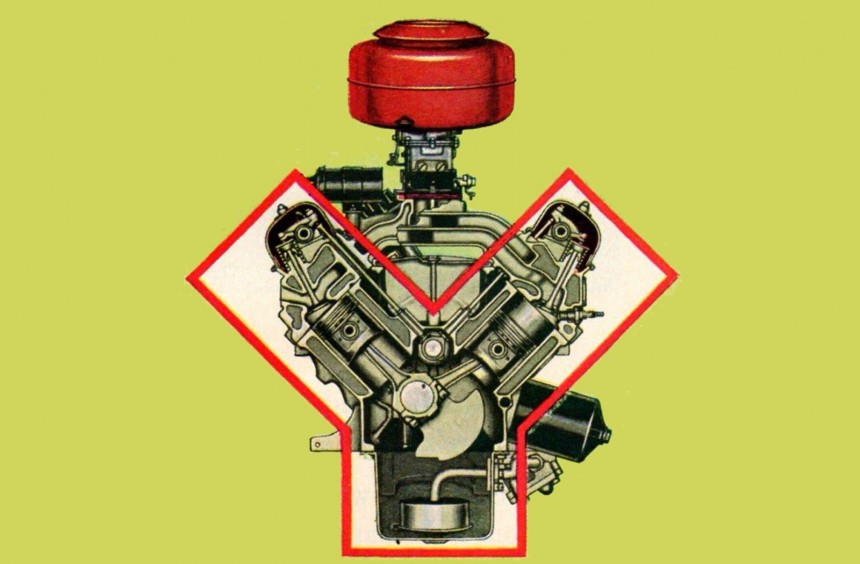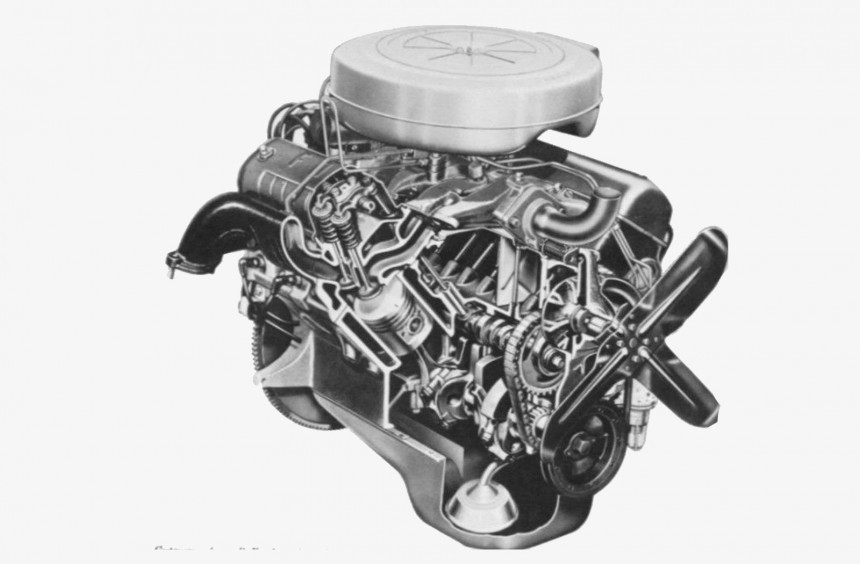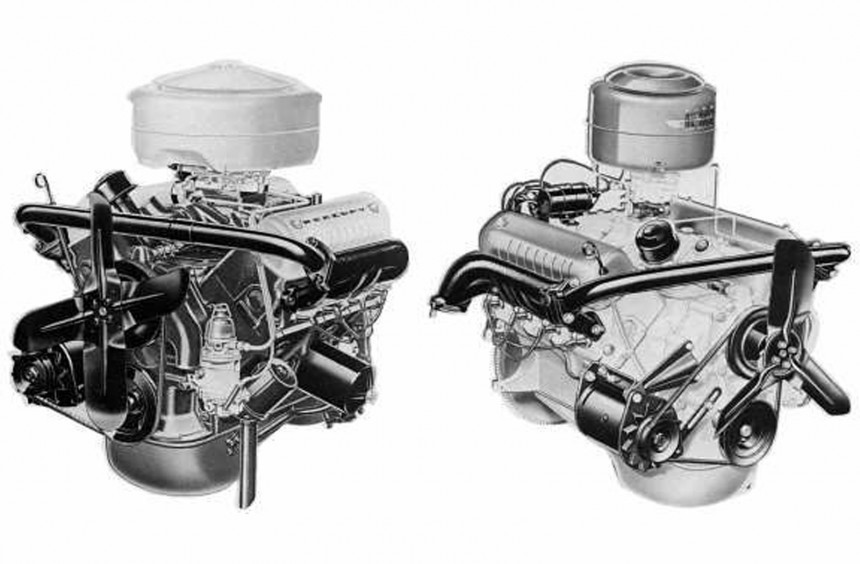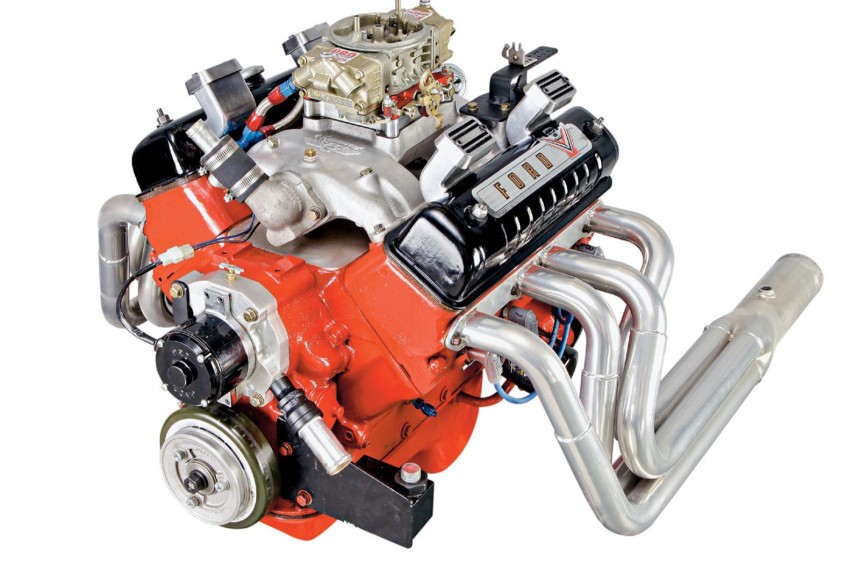Though not designed for high performance, Ford's first overhead-valve (OHV) V8 was a solid engine. These days, when it's equipped with modern tech, the Y-Block can make some respectable output figures, despite its 70-year-old design.
The V8 engine was born in France, but after the layout made it across the Atlantic, it became as American as apple pie. Straight-cylinder engines remained popular alternatives to the handful of rather expensive American V8s during the 1910s and 1920s. However, once Ford introduced the iconic Flathead in 1932 and made it available in more affordable cars, the V8 became the weapon of choice for the entire US automotive industry.
By the late-1960s, Detroit's Big Three was engaged in a horsepower war that delivered some of the most powerful V8 engines that were available anywhere in the world back then. Mounted inside the engine bays of muscle cars, these powerplants became automotive legends that are still revered today.
When talking about iconic Ford V8s from the muscle car era, enthusiasts will mention the 289 small-block K-code, the multitude of high-powered big-block 427s, the 428 Cobra Jet, or even the rare, race-bred SOHC 427 Cammer.
In between the game-changing era of the Flathead and the glorious years of the muscle, Ford developed an equally legendary yet much tamer V8 that deserves to be remembered.
In the years following the Second World War, the Flathead was still going strong, powering nearly all of Ford's offerings and being America's most popular engine. Nevertheless, it had reached its ceiling in terms of development potential and power, so Ford needed to develop a brand-new V8.
Therefore, during the early-1950s, Ford's brightest engineers got to work and designed a worthy successor for the Flathead. The new engine was ready to be released during the 1953 model year, but due to the nickel shortage caused by the American industry's involvement in the Korean War, its debut was postponed for 1954.
The new V8 offered an 18 percent increase in power compared to the latest Flathead, all while having the same displacement and a similar weight. Moreover, it delivered twice as much horsepower and torque as the initial Flathead of 1932.
As its name implies, the engine was based on a new deep-skirted, cast-iron cylinder block that resembled the letter Y.
Displacing 239 ci (3.9 liters), it had a larger bore and shorter stroke than its predecessor- changes that reduced friction and increased reliability in the long run.
Its top end featured an overhead cam, a common-plane valve layout, and shaft-mounted rocker arms, all of which were advanced, yet common designs for that era.
That being said, Ford's Y-block had a fair share of quirks that weren't all that common among the V8s of the 1950s. Unquestionably the most uncommon feature was its intake port configuration. The ports were slotted vertically in pairs instead of standing side by side horizontally. In other words, the ports stood on top of each other, making sharp turns around the head bolts.
Apart from that, the Y-block had an unusual firing order (1-5-4-8-6-3-7-2), solid, mushroom-type lifters installed from the bottom of the block, and a weird lubrication system comprised of tiny passageways in the heads. The latter feature was the engine's Achilles, as the passageways would often clog due to the low content of detergents of the engine oils available back then. However, Ford fixed this issue in latter versions using an external tube that fed oil directly to the rocker shafts.
Available in most 1954 Ford cars and trucks, the initial 239 Y-block was rated at 130 hp and 214 lb-ft (290 Nm) of torque. Mercury customers were treated to a slightly-larger 256-ci (4.1-liter) version that made 161 hp and 238 lb-ft (322 Nm) of torque.
With the introduction of rivals Chevrolet's 265-ci (4.3-liter ) Turbo-Fire small-block V8 in 1954, Ford realized that it needed to up the ante, so for the 1955 model year, the Y-blocks were enlarged. The standard version grew to 272 ci (4.4 liters), which led to an output of 162 hp. The Mercury version (also used in the Ford Thunderbird) was bumped up to 292 ci (4.7 liters), enabling it to make up to 198 hp when paired with an automatic transmission.
Though their displacement remained unchanged, the 272 and 292 were continually improved until the newer Windsor V8 replaced them during the 1960s. The biggest factory output figures stood at 190 hp for the 265 and 212 hp for the 272.
The Y-block's largest, most powerful version was introduced in 1956 and was available in high-end Ford (most notably, the Thunderbird) and Mercury models. Displacing 312 ci (5.1 liters), it initially made 210 hp with manual transmissions and 225 hp with automatics, but with the introduction of a dealer-installed option that featured a hotter cam, revised heads, and an intake manifold with dual four-barrel carbs, power rose to 260 hp.
Finally, a Paxton supercharged version became available in 1957. Conservatively rated at 300 hp and 300 lb-ft (406 Nm), it became Ford's most potent production Y-block.
Produced until the mid-1960s in the US and all the way until the 1980s in South America, Ford's Y-block established itself as a rugged, reliable, easy-to-maintain V8 that honorably carried the V8 torch from the Flathead.
It was the weapon of choice for plenty of early hotrodders, and it's still being used by some current builders who love its unmistakably throaty sound. With the help of modern fabrication methods and hardware, rebuilt Y-blocks are currently known for being capable of well over 500 hp, despite their old-fashioned design.
It's also worth mentioning that the engine introduced in 1954 was not FoMoCo's first nor last Y-block. Lincoln introduced a new OHV V8 that was also known as Y-block in 1952, but it shared nothing more than the block shape, distributor location, and oil pump with the Ford unit. Still, it most likely influenced the design of the Ford version.
The Lincoln Y-block was replaced in 1958 by the MEL series (Mercury-Edsel-Lincoln) of big-block V8s, which were also built around a Y-shaped block. Mercury's high-performance Super Marauder version of 1958 was the most famous of these. Rated at 400 hp and 500 lb-ft (677 Nm) of torque, it was the most powerful production V8 built in the US at the time of its release and remains the first American production engine to reach the 400-hp mark.
For more on this legendary engine, we recommend watching the YouTube video below by The Horsepower Monster.
By the late-1960s, Detroit's Big Three was engaged in a horsepower war that delivered some of the most powerful V8 engines that were available anywhere in the world back then. Mounted inside the engine bays of muscle cars, these powerplants became automotive legends that are still revered today.
When talking about iconic Ford V8s from the muscle car era, enthusiasts will mention the 289 small-block K-code, the multitude of high-powered big-block 427s, the 428 Cobra Jet, or even the rare, race-bred SOHC 427 Cammer.
In between the game-changing era of the Flathead and the glorious years of the muscle, Ford developed an equally legendary yet much tamer V8 that deserves to be remembered.
The Flathead's successor
Therefore, during the early-1950s, Ford's brightest engineers got to work and designed a worthy successor for the Flathead. The new engine was ready to be released during the 1953 model year, but due to the nickel shortage caused by the American industry's involvement in the Korean War, its debut was postponed for 1954.
The new V8 offered an 18 percent increase in power compared to the latest Flathead, all while having the same displacement and a similar weight. Moreover, it delivered twice as much horsepower and torque as the initial Flathead of 1932.
A solid architecture with a few quirks
Displacing 239 ci (3.9 liters), it had a larger bore and shorter stroke than its predecessor- changes that reduced friction and increased reliability in the long run.
Its top end featured an overhead cam, a common-plane valve layout, and shaft-mounted rocker arms, all of which were advanced, yet common designs for that era.
That being said, Ford's Y-block had a fair share of quirks that weren't all that common among the V8s of the 1950s. Unquestionably the most uncommon feature was its intake port configuration. The ports were slotted vertically in pairs instead of standing side by side horizontally. In other words, the ports stood on top of each other, making sharp turns around the head bolts.
Apart from that, the Y-block had an unusual firing order (1-5-4-8-6-3-7-2), solid, mushroom-type lifters installed from the bottom of the block, and a weird lubrication system comprised of tiny passageways in the heads. The latter feature was the engine's Achilles, as the passageways would often clog due to the low content of detergents of the engine oils available back then. However, Ford fixed this issue in latter versions using an external tube that fed oil directly to the rocker shafts.
Becoming more powerful
With the introduction of rivals Chevrolet's 265-ci (4.3-liter ) Turbo-Fire small-block V8 in 1954, Ford realized that it needed to up the ante, so for the 1955 model year, the Y-blocks were enlarged. The standard version grew to 272 ci (4.4 liters), which led to an output of 162 hp. The Mercury version (also used in the Ford Thunderbird) was bumped up to 292 ci (4.7 liters), enabling it to make up to 198 hp when paired with an automatic transmission.
Though their displacement remained unchanged, the 272 and 292 were continually improved until the newer Windsor V8 replaced them during the 1960s. The biggest factory output figures stood at 190 hp for the 265 and 212 hp for the 272.
The Y-block's largest, most powerful version was introduced in 1956 and was available in high-end Ford (most notably, the Thunderbird) and Mercury models. Displacing 312 ci (5.1 liters), it initially made 210 hp with manual transmissions and 225 hp with automatics, but with the introduction of a dealer-installed option that featured a hotter cam, revised heads, and an intake manifold with dual four-barrel carbs, power rose to 260 hp.
Finally, a Paxton supercharged version became available in 1957. Conservatively rated at 300 hp and 300 lb-ft (406 Nm), it became Ford's most potent production Y-block.
A Blue Oval legend
It was the weapon of choice for plenty of early hotrodders, and it's still being used by some current builders who love its unmistakably throaty sound. With the help of modern fabrication methods and hardware, rebuilt Y-blocks are currently known for being capable of well over 500 hp, despite their old-fashioned design.
It's also worth mentioning that the engine introduced in 1954 was not FoMoCo's first nor last Y-block. Lincoln introduced a new OHV V8 that was also known as Y-block in 1952, but it shared nothing more than the block shape, distributor location, and oil pump with the Ford unit. Still, it most likely influenced the design of the Ford version.
The Lincoln Y-block was replaced in 1958 by the MEL series (Mercury-Edsel-Lincoln) of big-block V8s, which were also built around a Y-shaped block. Mercury's high-performance Super Marauder version of 1958 was the most famous of these. Rated at 400 hp and 500 lb-ft (677 Nm) of torque, it was the most powerful production V8 built in the US at the time of its release and remains the first American production engine to reach the 400-hp mark.
For more on this legendary engine, we recommend watching the YouTube video below by The Horsepower Monster.
